Don't let old age be an obstacle to your travel. This tour is one of the best China tours for seniors. Beijing and Shanghai are the most symbolic cities of China, and you will visit these two cities at a slow pace. To make sure you will be taken good care of, we will do small group tours for seniors. In this tour, we will do our best to leave you less walking. You will visit Great Wall by cable car, visit Hutong by rickshaw, and visit West Lake by cruise. Also, we can meet your other special needs, like a wheelchair, walking stick, stick chair, etc. Contact us now!

We are glad to meet you in Beijing, the capital of China! You will enjoy a 9-day China tour here.
Upon arrival in Beijing, you will be picked up at the airport by our guide with your name sign. Then, the driver will take you to the hotel, and you can have a good rest. On the way to the hotel, you can have a first impression of Beijing as your guide share some attractive and amazing stories with you about the city.
Start your day with a nice breakfast at the hotel and you will be energized to begin a pleasant trip.
Beijing boasts a distinctive position nationwide and worldwide due to its achievements in politics, economy, culture, medicine, scientific and technological innovation, and so on. It is also a city of historic buildings and cultural attractions. This morning you are first led to Tian’anmen Square, which lies at the intersection of the central axis of Beijing. Originally built in the 15th year (1417) of the reign of the Emperor Yongle of the Ming Dynasty (1368 - 1644), Tian’anmen was first called Chengtianmen. It was twice destroyed in the Ming Dynasty, once by lightning and once by war. In 1651, the 8th year of Emperor Shunzhi in the Qing Dynasty (1636 - 1912), it was rebuilt on a large scale and was changed into Tian’anmen. Tian’anmen was the place for important ceremonies during the Ming Dynasty and Qing Dynasty when imperial edicts were issued for coronation of emperors or the conferring of the title of empresses. Moreover, since the founding of the People’s Republic of China, Tian’anmen Square has been renovated and expanded many times. Now the square covers a total area of 440,000 square meters, 880 meters long, and 500 meters wide. To its east, there is the National Museum of China; to its west, there is the Great Hall of the People. Moreover, the Monument to People’s Heroes stands in its center and Chairman Mao’s Memorial Hall is to its south.
Tian’anmen Square was formerly a courtyard in front of the main gate to the Forbidden City (closed each Monday). After walking through Tian’anmen Square, you can visit the imperial palace. The age-old palace, where 24 emperors had ruled the nation for several centuries, has witnessed the rise and fall of the Ming and Qing Dynasties. The very reason why it is called the Forbidden City is that emperors have the supreme power and commons are forbidden to enter the imperial palace. With a total coverage of 720,000 square meters, it has over 9,000 rooms inside, including the palaces as homes and the halls as offices. Its construction lasted 14 years. Furthermore, it is the largest existing wood-structure building complex with painted beams and sumptuous decorations. If you have an interest in Chinese Feng Shui, you can understand its design principles of “live in harmony with nature and maintain balance of Yin and Yang”.
After lunch, you will visit the Summer Palace which in ancient times was a desirable paradise for most people when China was mostly seized by hot summers. But it served as a site only for the ancient imperial family to spend the summertime. The Summer Palace, formerly known as the Garden of Clear Ripples, is situated in the western suburbs of Beijing, 15 kilometers away from the city center. It occupies an area of about 290 hectares and is mostly dominated by Kunming Lake and Longevity Hill. It is a large landscape garden that has absorbed the design techniques of south China’s gardens. It is also the best-preserved imperial palace garden and accepted as the “Royal Garden Museum”.

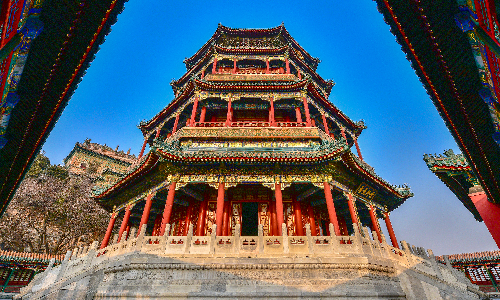
This morning, we will drive north for about 1 hour (45 KM) to visit the Ming Tombs. You can have a chance to learn about another kind of Chinese culture – burial culture. The Ming Tombs, as the tombs of thirteen emperors in the Ming Dynasty, were built from 1409 to 1645. With an area of about 120 square kilometers, it is considered the largest tomb area where the most emperors and empresses were buried in China and even the world. Today, we are especially going to see the Ding Tomb of the Ming Tombs. Ding Tomb is for the 13th emperor of the Ming Dynasty, the Emperor Wanli, and his two empresses. It was built between 1584 and 1590 (from the 12th year to the 18th year of the reign of the Emperor Wanli). Ding Tomb is one of the three largest tombs among the Ming Tombs. It is the only one of the Ming Tombs that has been excavated. Ding Tomb Underground Palace is open to visitors.
This afternoon, we are headed for the Great Wall. As an old Chinese saying goes, one who has never been to the Great Wall is not a hero. Therefore, once you come to China, it is advisable to appreciate the unbelievably man-made wonder. The total length of the existing Great Wall is more than 20,000 kilometers. The construction of the Great Wall began in the Spring and Autumn and the Warring States Periods (770 BC - 221 BC) and ended in the Qing Dynasty, with a history of over 2,000 years. It was listed as the World Cultural Heritage in 1987. Today we will walk along one section of the Great Wall called the Mutianyu Great Wall. The Mutianyu section, constructed in the Ming Dynasty, extends through Huairou District, Beijing. It receives much fewer tourists than any other section. In 2014, former U.S. President Barack Obama's wife and daughters visited the Mutianyu Great Wall.
When we go back to the hotel, you will have a photo stop at the Bird’s Nest and Water Cube, also known as the National Stadium and National Aquatics Center. They are both popular for their unique building structures and shapes. They used to be the venues of the 29th Olympic Games in China in 2008. And now, they are also used for other sports events or conferences.

Today we will begin with a special attraction, Beijing Hutong. It can be said that not knowing Hutong is knowing nothing about the real life of those who live in Beijing. Hutong has been kept and developed since the establishment of the capital of the Yuan Dynasty (1271 - 1368) in 1267. So far it is over 700 years old. It is decorated by gray tiles and walls, red gates, and narrow alleys, and with rich stories and legendary experiences scattering on each of them. The name of Beijing Hutong comes from life. They were named after plants and animals, people’s name, direction, dialect and so on. At the first sight of a hutong, you may not be immediately impressed. But after strolling freely through them, you will feel what local life is really like. Unlike other travel agencies that only take you on a quick rickshaw tour of the hutongs, we also add home visits to give you a deeper understanding of hutong culture.
Then, you will visit the Temple of Heaven. It was built in the south of Beijing in the 19th year (1420) of Emperor Yongle in the Ming Dynasty. Emperor Qianlong (1739 - 1796) and Emperor Guangxu (1875 - 1908) got it rebuilt in the Qing Dynasty. It was the place for emperors to worship the God of Heaven and pray for a sound harvest in the Ming and Qing Dynasties. Since 1420 when the construction of the Temple of Heaven was finished, a total of 22 emperors had visited it in person and prayed here. Nowadays, the Temple of Heaven is a very popular park where people do Tai Chi or some other morning exercises.
After lunch, you will go to the Beijing Zoo. Covering an area of about 86 hectares, Beijing Zoo was founded in 1906, the thirty-second year of Emperor Guangxu of the Qing Dynasty. It is the largest zoo nationwide. There are more than 500 kinds of animals with a quantity of over 5,000, and more than 500 species of marine fish and marine creatures with over 10,000. At the beginning of its establishment, the zoo received a continuous flow of people. The most attractive part of Beijing Zoo is the Panda House. Those who love the charmingly naive pandas can easily get close to them in the zoo. In order to welcome the 11th Asian Games in 1990, Panda House was so carefully designed and creatively built that it was chosen as “Top Ten Buildings in Beijing”. In history, politicians from many other countries have visited the Beijing Zoo, and the wives of several Japanese prime ministers have visited the Panda House. All the time the national treasures are waiting for you.

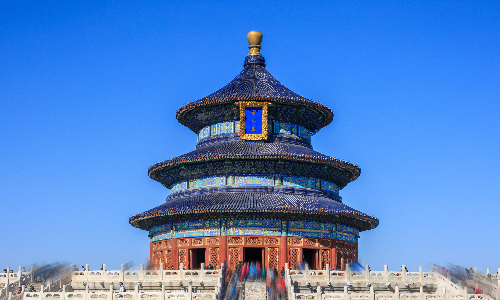
 Shanghai
Shanghai This morning, you will say goodbye to Beijing and head for Shanghai. You will take the estimated high-speed train CA8680 12:25/14:55 to Shanghai. After arrival in Shanghai, your Shanghai guide will pick you up at the train station and transfer you to the hotel.
Shanghai, located in eastern China, is a noted international metropolis. It is also known as the golden triangle of China’s tourism along with Beijing and Xi’an. It abounds in tourist attractions of traditional Chinese culture, such as Jade Buddha Temple and classic Yu Garden. In addition, it is a very modern city with a variety of advanced innovations.
 Hangzhou
Hangzhou Shanghai
Shanghai This morning we will drive about 200 KM for 2.5 hours to Hangzhou. You must have heard the old saying in China “Up above there is paradise; down below there are Suzhou and Hangzhou.” Today, you will have a good day here in Hangzhou. First, your guide will take you to visit the West Lake. It will be the best way to take the West Lake cruise to go sightseeing. You may see the herons on the water, and squirrels and monkeys on the trees by the lake. There are 119 species of birds and more than 20 species of mammals in the West Lake Scenic Area. Inside the lake area exist many beautiful spots, such as Broken Bridge on the West Lake, Leifeng Pagoda, and Su Causeway.
After lunch, you will go to another must-see place, Six Harmonies Pagoda. The Six Harmonies Pagoda has 104 iron bells hanging from the eaves of each floor. The 59.89m high pagoda is made of bricks with wooden eaves. The pagoda is of historic, cultural, and artistic significance as the most important Song Dynasty (960 - 1279) building in the ancient city of Hangzhou. Around the pagoda are lush trees and plants. And on the pagoda, you will overlook the spectacular Qiantang River and the Qiantang River Bridge.
Then, you will visit Dragon Well Tea Plantation. You may have a chance to learn tea making from picking tea leaves to drying the tea leaves. Besides, you will taste the well-known Dragon Well Tea. The tea enjoys a great reputation and ranks first among the top ten famous teas in China. Chinese people believe that Dragon Well Tea has the function of inhibiting the aging of blood vessels , lowering cholesterol , and eliminating fatigue. At the end of the day, you will be driven back to Shanghai.
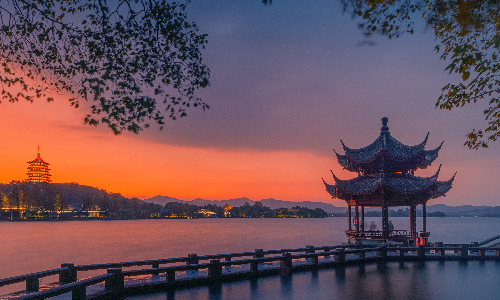

 Suzhou
Suzhou Shanghai
Shanghai Today we will drive about 100 KM for about 1.5 hours to Suzhou. This morning, our first destination is the Humble Administrator’s Garden. Founded in 1509 during the reign of Emperor Zhengde in the Ming Dynasty, the Humble Administrator’s Garden has a history of 500 years. It is the epitome of classical gardens in the south of the Yangtze River and the largest private garden in China. The whole garden consists of four parts, including East Park, Central Park, West Park, and residential area. The south of the garden houses the Suzhou Garden Museum. The garden makes the best of flowers and other plants, with the Azalea Festival and Lotus Festival staged each spring and summer.
After lunch, we will first go to the Master-of-Nets Garden. The garden is listed as the world cultural heritage as well as one of the four famous gardens in Suzhou. It is a typical house garden in Suzhou and a representative work of small and medium-sized classical gardens in South China. The Master-of-Nets Garden can be divided into three parts: the east park as a mansion, the middle as the main park, and the west as an inner park. Small as it is, the garden is of immense view.
Next, we are going to see Suzhou Silk Museum (closed each Monday). Suzhou Silk Museum is China’s first museum specializing in silk. The museum houses six exhibition halls including the Ancient Silk Exhibition, the Modern Silk Exhibition, the Special Exhibition for Children, the Mulberry Yard, the Silk Weaving Machinery Exhibition, and the Silk Cultural Art Gallery named after Master Qian Xiaoping (a silk expert). The museum demonstrates a 6000-year-old silk history from fabulous silk cultural relics, mulberry planting, silkworm breeding to finished garments. Besides, there are both performances of traditional silk weaving and application of modern silk weaving technology to daily life. The museum is a combination of static exhibits and dynamic activities. After that, we will drive back to Shanghai.

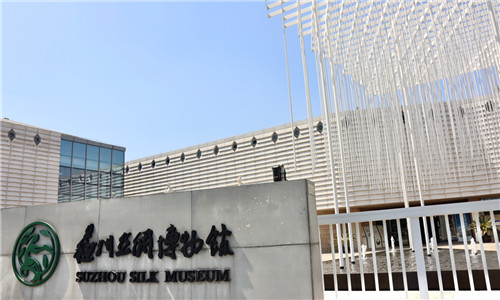
Today we will visit some attractions in Shanghai. In the morning you are going to see Yu Garden, which is a classical garden in South China. It was originally a private garden in the Ming Dynasty and has a history of more than 400 years. It was an ancient Chinese official who built the elegant garden for his retired father. Many senior officials abroad have been to the garden when visiting China. Then, you will have some free time travelling around the nearby bazaar where you can not only buy the nice silk products, but also taste the authentic Shanghai snacks.
Next, you are led to Jade Buddha Temple. It is not only a renowned temple in Shanghai, but also a famous Buddhist temple at home and abroad. As one of the top ten tourist attractions in Shanghai, the temple is hailed as a pure land in the busy and bustling urban area. Here you can feel peace and get rid of the worldly affairs.
After lunch, we will first go to Shanghai Tower. Shanghai Tower is a super high-rise building gathering business, office, hotel, commerce, entertainment, and sightseeing. With a total height of 632 meters, it is currently the tallest building in China and the second tallest one in the world. The Top of Shanghai Observatory is on the 118th floor to which the world’s fastest elevator can take you. From there you can have a bird’s-eye view of noted buildings, natural beauties, and an ever-changing sky.
Then, we will visit the most popular shopping street in Shanghai, Nanjing Road. If you are a shopping lover, you can purchase whatever you want, for there are all kinds of brand stores and specialty shops. Additionally, it is a good choice to walk along this pedestrian street to taste various Chinese food.
Finally, you are directed to the last place, the Bund. Standing by the bank of the Huangpu River, it is the symbol of Shanghai. There exist the exotic building clusters in the Bund of Shanghai as well. In particular, you can enjoy a delightful night scene here. After one day’s tour, you will be transferred back to your hotel.

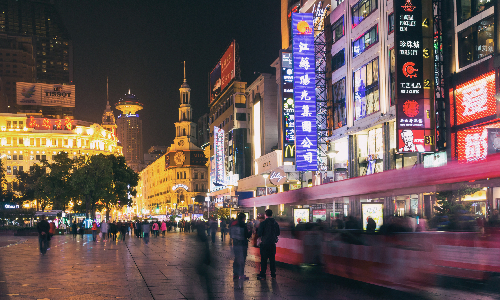
Today your China tour comes to an end. We will take you to the airport according to your flight, and you will fly back to your sweet home. We hope to serve you again.
Author: Zhenzhen Zhu
Proofreader: Carrie Zhang
| City | Five Star hotel list | Four Star hotel list |
|---|---|---|
| Beijing | Sunworld Dynasty Hotel Beijing Wangfujing | Sunworld Hotel Wangfujing |
| Shanghai | Ocean Hotel Shanghai | Courtyard by Marriott Shanghai Central |
 |
![]() About your child or infant, please contact us for a discounted price.
About your child or infant, please contact us for a discounted price.



We started with a few days in Beijing & ended in Shanghai, from where we visited the Forbidden City and Great Wall. In between we visited Terra Cotta Warriors Museum, Panda Base, Shanghai Disneyland.

We had a wonderful holiday in China which will remain long in the memory. China is a breathtakingly beautiful country full of splendid temples and palaces, mountains and rivers, peaceful rural scenes and bustling shopping streets.
 QUICK ENQUIRY
QUICK ENQUIRY